About Us
Municipal Sustainability Plan
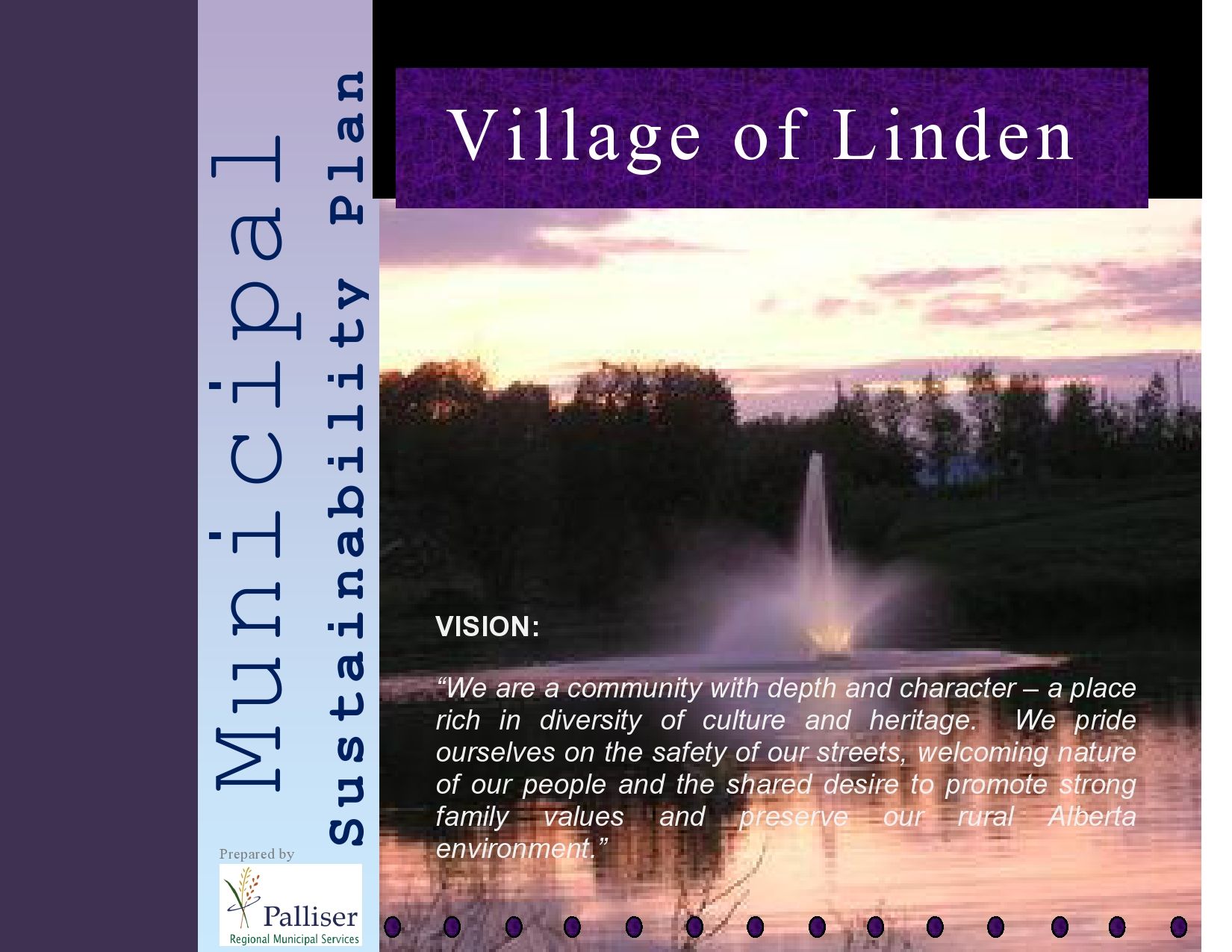
Acknowledgement Page
Palliser Regional Municipal Services would like to thank the following contributors:
The Municipal Sustainability Plan Steering Committee:
Vanessa Van der Meer
Darwyn Moon
Joanne Weller
Christine Coggins
Wanda Malsbury
Shawn Campbell
Chuck Tomlinson
Lloyd Ratzlaff
Lloyd Miller
Claudia Lauper
Jamie Collins
Donnie Collins
Village of Linden Council:
Mayor Annon Hovde
Deputy Mayor Darwyn Moon
Councilor Florence Robinson
Councilor Leslie Hibbs
Councilor Vanessa Van der Meer
TABLE OF CONTENTS
INTRODUCTION
WHAT IS SUSTAINABILITY?
WHAT IS A MUNICIPAL SUSTAINABILITY PLAN
WHY?
PROJECTS ELIGIBLE FOR FUNDING
MUNICIPAL SUSTAINABILITY PLANS & OTHER MUNICIPAL PLANNING DOCUMENTS
UNDERSTANDING SUSTAINABILITY
DEVELOPING A SUSTAINABILITY PLAN-SUSTAINABILITY PRINCIPLES
THE FIVE PILLARS
THE FIVE PILLARS OF THE SUSTAINABILITY COMMUNITY
METHODOLOGY & PROCESS DEVELOPMENT
COMMON ELEMENTS OF SUCCESSFUL MSPS
SECURE COUNCIL’S COMMITMENT
COMMUNITY
FITTING IN OTHER PLANS
GATHERING COMMUNITY INPUT
DEVELOPING A SUSTAINABIILITY PLAN – 5 PHASE APPROACH
IMAGINE THE FUTURE – PHASE 1
DEFINE SUCCESS – PHASE 2
CURRENT REALITY – PHASE 3
ACTION PLAN – PHASE 4
IMPLEMENTATION & MONITORING – PHASE 5
LINDEN’S SUSTAINABLE FUTURE – CONCLUSION
BACKCASTING ANALYSIS – APPENDIX A
ACTION PLANS – APPENDIX B
“The future is not something we enter.
The future is something we create”
– Leonard I. Sweet, Author/Futurist
Introduction
Welcome to the Village of Linden’s journey to municipal sustainability. The following document presents key material undertaken by Linden in cooperation with Palliser Regional Municipal Services Company Ltd (PRMS). This document is structured to take the reader through the background, preparation and approval process for Linden’s Municipal Sustainability Plan (MSP).
The key elements to note are:
• Linden’s definition of sustainability
• The origins of municipal sustainability
• How Linden’s process was shaped by The Natural Step framework for decision making
• How AUMA’s concept of the Five Pillars of Sustainability has been utilized
• The AUMA process for creating a Municipal Sustainability Plan
• The Results!
The process began with the Village of Linden corresponding with Palliser Regional Municipal Services to facilitate in a municipal sustainability plan. Linden organized a steering committee. Subsequently Council, Administration and the steering committee took training in The Natural Step. After training, the steering committee got down to business compiling current reality data, creating descriptions of success and action plans to achieve the goals set out in the descriptions of success.
Ultimately, this process was undertaken to meet the requirements set out in the revenue sharing agreements between the federal, provincial and municipal governments under the New Deal for Cities and Communities
What is Sustainability?
“Sustainability” is defined as living in a way that meets the needs of the present without comprising the ability of future generations to meet their own needs.
Municipal Sustainability Planning is an opportunity for municipalities to look long-term at the communities they want and take proactive steps to move there.
What is a Municipal Sustainability Plan?
According to the Alberta Urban Municipalities Association Guidebook to sustainability, on which this planning exercise is based, a Municipal Sustainability Plan is:
A high level overarching document that guides the community into the future. It can best be viewed as a strategic business plan for the community that identifies short, medium, and long term actions for implementation, tracks and monitors progress, and is reviewed and revised on an annual basis. An MSP, therefore, provides guidance for the development or alignment of all municipal plans and documents.
Why?
In 2004, the Federal Government outlined plans to give municipalities a portion of the federal gas tax. One of the principles for sharing these taxes was the concept of “environmental sustainability”, which became known as the “New Deal for Cities and Communities” or as the “Gas Tax Fund”. In order for communities to continue to access the maximum funding available from the federal government, the federal-provincial agreement states that all municipalities will have to develop an Integrated Community Sustainability Plan. Eligible capital based projects which can be funded through this program include public transit, community energy, local roads, water, wastewater and solid waste infrastructure improvements. Funds can also be utilized for capacity building within a community, including development and implementation of a Sustainability Plan, collaborative, integrative or knowledge based infrastructure improvements and transportation studies which address safety and/or environmental impact concerns. The level of funding is based on an annual capital allotment.
A MSP is essentially a high level document that guides your community into the future. It can be best viewed as a strategic business plan for your community that identifies short, medium and long term actions for implementation, tracks and monitors progress, and is reviewed and revised on an annual basis. Your MSP will reflect on what your community wants and help move your community towards your desired state rather than reacting to problems as they arise.
The Alberta Urban Municipalities Association (AUMA) supports and encourages communities in the creation of Municipal Sustainability Plans. A Municipal Sustainability Planning Guide, created by AUMA , and available online at www.msp.auma.ca, was extensively referenced throughout the creation of this document.
Projects Eligible for Funding
Projects eligible for funding under the New Deal for Cities and Communities are as follows:
Public Transit:
• Rapid Transit: includes light rail, heavy rail additions, subways, ferries, park and ride facilities.
• Transit Buses: bus and/or bus stations.
• Transportation signaling, passenger and traffic information and transit operations
• Capital investments, such as High Occupancy Vehicle (HOV) lanes.
Water
• Drinking water supply, drinking water purification and treatment systems, drinking water distribution systems, water metering systems.
Wastewater
• Wastewater systems, including sanitary and storm water systems.
Solid Waste
• Waste diversion, material recovery facilities, organics’ management, collection depots, waste disposal landfills, thermal treatment and landfill gas recuperation.
Community Energy Systems
• Cogeneration or combined heat and power projects (where heat and power are produced through a single process).
• District heating and cooling projects [where heat (or cooling) is distributed to more than one building].
Active Transportation Infrastructure
• Local roads, bridges, tunnels and pedestrian systems that enhance sustainability outcomes.
Capacity Building
• Collaboration: building partnerships and strategic alliances, participation, and consultation and outreach.
• Knowledge: use of new technology, research, and monitoring and evaluation.
• Integration: planning, policy development and implementation (e.g., environmental management systems, life cycle assessment).
Municipal Sustainability Plans and Other Municipal Planning Documents
The role of the Municipal Sustainability Plan is to set targets as a roadmap to where energy efficient technologies are the norm and resource conservation is wide ranging. The MSP is to be used in co-operation with other planning documents.
By carrying out public consultation, the proposed actions have full community support. The intent is that when Council directs resources into actions discussed within the MSP, broad community support should be forth coming.
Capital Planning
This plan would have the most influence on the yearly Capital Plan, where Council determines where to best invest resources. After all, since the purpose of the Municipal Sustainability Plan is to direct the spending of the gas tax allocation, it is key the items presented for action become part of future municipal works. The key to success of the Municipal Sustainability Plan is ensuring the activities proposed translate into concrete actions via monetary or social capital investments.
Municipal Development Plan
The Municipal Development Plan (MDP), supports and promotes initiatives which are ecologically and environmentally friendly. An MDP addresses such items as the direction and timing of new development and conditions regarding how growth and development occurs. As such, the MSP can be considered the municipal document which sets out citizen-derived development intensions and the MDP organizes the implementation of these intentions.
Land Use Bylaw
The Land Use Bylaw (LUB) is more prescriptive than the MDP by controlling the technical use and development within the municipality. This is achieved by regulating specific uses, setbacks and development standards. The LUB also defines the development approval process, guiding proposals for growth through the municipal approvals system from concept to construction. This MSP should have significant impact on future LUBs by compelling developers and citizens to construct buildings in a fashion which supports the pillars of sustainability presented herein.
Area Structure Plans
An Area Structure Plan (ASP) sets the development pattern for undeveloped land. Essentially ASPs describe the phasing, proposed land uses, population densities and sequence of development. They indicate transportation routes, utility corridors, open space and built-up areas. Future ASPs will be required to have a section within the plan indicating how the future development will meet the principles of the five pillars of sustainability.
Understanding Sustainability
Supported by the AUMA, “The Natural Step” (TNS) is a universally adopted approach which was developed by Dr. Karl-Henrik Robert to create a framework for discussion of sustainable concepts. With declining resources and increasing demand for these resources, one of the components is the “Funnel” (Figure 1) created by a narrowing margin between these resources. In order to keep these two lines from intersecting, sustainability planning is crucial. First, awareness of the current situation must be understood. Then, by a method of “Backcasting” (Figure 2), which means starting first with the desired outcome in mind and then identifying present day actions to move in the direction of that outcome. The outcome, or “vision”, should also be consistent with sustainability principles to ensure that the basis for our economy and livelihood, i.e. natural systems and the materials and services they provide, are protected for future generations to access.
Figure1 – The Funnel Figure
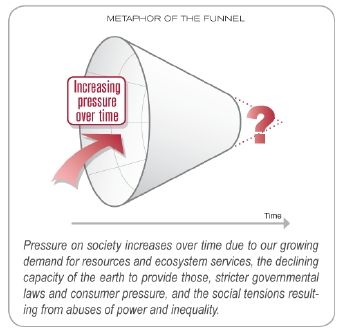
2 – Backcasting

Source: http://www.thenaturalstep.org/en/canada
Developing a Sustainability Plan for Linden – Sustainability Principles
As suggested in the AUMA’s guidelines for communities creating a Municipal Sustainability Plan, the following principles are to guide future strategies and actions in the Village to provide a long term sustainable future:
1 Provide a long-term vision for Linden based on sustainability; intergenerational, social, economic and political equity; and our community’s individuality.
2 Achieve long-term economic and social security.
3 Recognize the intrinsic value of biodiversity and natural ecosystems, and protect and restore them.
4 Enable Linden to minimize our ecological footprint.
5 Build on the characteristics of ecosystems in the development and nurturing of a healthy and sustainable community.
6 Recognize and build on the distinctive characteristics of Linden, including our human and cultural values, history and natural systems.
7 Empower people and foster participation.
8 Expand and enable cooperative networks to work towards a common, sustainable future.
9 Promote sustainable production and consumption, through appropriate use of environmentally sound technologies and effective demand management.
10 Enable continual improvement, based on accountability, transparency and good governance.
Principles of sustainability, in accordance with The Natural Step method, are used to guide decisions made in a community to move it toward a more sustainable future. In a sustainable society:
Nature is not subject to systematically increasing
– Concentrations of substances extracted from the Earth’s crust
– Concentrations of substances produced by Society
– Degradation by physical means; and
– People are not subject to conditions that undermine their ability to meet their basic human needs.
The Five Pillars
Moreover, the Municipal Sustainability Plan (MSP) will reinforce the community’s vision statement, goals and strategies and provide tools to assess the implications of decisions in five areas, as referred to in the AUMA guide as the “five dimensions of sustainability”. These dimensions are:

The Five Dimensions of the Sustainable Community
• Environment – Preserving quality and natural built environments that minimize the negative impacts of development.
• Economy – Creating a flourishing and diverse local economy through decisions that create conditions conducive to economic development and communities in which people want to live and do business.
• Society – Allowing the growth of communities that promote stability, diversity and a high quality of life for all.
• Culture – Celebrating vibrant and festive communities for the expression and enhancement of a distinct identity and strong sense of place.
• Governance – Ensuring transparent, collaborative, and inclusive decision making in which representation and leadership is accountable to the community.
With an understanding of these sustainability principles and concept of the five dimensions of sustainability, the next step taken was to engage in a process for the development of an MSP.
Methodology & Process Development

Common Elements of Successful MSPs
Some common elements of successful Municipal Sustainability Plans include:
Political will to commit resources: Having the political will to implement the plan accompanied by an adequate commitment of financial and personnel resources. Although the process is meant to engage the broader community, its success or failure will rest on the leadership and support of Council to the process. This leadership will be called upon throughout the process to provide guidance and steer the process in case problems arise. It is for this reason that AUMA will also offer an alternate and less comprehensive Guidebook for Municipal Sustainability Planning. Before municipal leaders choose the leadership path that includes full engagement of the community, the role and obligations of the municipal leaders must be fully understood and committed to. Sustainable community/municipal planning can begin with a shorter process than the one found in this version of the Guidebook.
Vision-Led Process: A desired vision of a successful outcome that generates energy and enthusiasm and gives purpose and meaning to inspire the contribution of time and effort.
Backcasting: Backcasting means starting first with the desired outcome in mind and then identifying present-day actions to move in the direction of that outcome. The outcome, or “vision”, should also be consistent with sustainability principles to ensure that the basis for our economy and livelihood, i.e. natural systems and the materials and services they provide, are protected for future generations to access.
Picking the low-hanging fruit: Low-hanging fruit are those actions that garner early agreement, are obtainable in the short-run, and can demonstrate success to generate momentum. In a community, this can be something as basic as getting a group together to clean up a visible vacant lot.
Democratic process: At the heart of Municipal Sustainability Planning is a commitment to a bottom-up participatory change process that engages citizens in designing the specific steps to move toward the desired vision. Using a democratic, participatory process to involve the “implementers”, i.e. partner organizations who will be responsible for implementing parts of the plan, is key to successful adoption and implementation of actions toward change.
Leading from the side: This describes a particular leadership style taken by process leaders that allows planning and action plans to emerge from the process, rather than imposing predetermined strategies or projects. Leadership from the side provides clear guidelines, then elicits ideas from participants for how to apply them.
Taking a systems approach: The approach to change is comprehensive and integrated, aimed at bringing about change throughout the range of planning areas. A conventional, less effective approach addresses issues on a one-by-one basis.
Broad involvement: A wide representation of community participants takes part both in the creation of a positive vision and in the steps toward achieving that vision. Broad involvement of citizens and implementers helps assure that change will happen, since those responsible for making it happen are involved in shaping the proposals from their beginning, again the idea of “involving the implementers”.
Keeping it going: Planning in cycles, testing early action proposals, ongoing education and training programs, monitoring the effectiveness of actions with indicators, all guided by the vision and sustainability principles, help institutionalize change and keep adopted practices going over time
Source: http://www.msp.auma.ca
Secure Council’s Commitment
At the Regular Meeting of Council held April 27, 2009 the following Resolution was presented and accepted, enabling a Citizen Advisory Group, to take action towards the creation of a Village of Linden Sustainability Plan.
RESOLUTION # 131:09
WHEREAS the Village of Linden has agreed to partner with Palliser Regional Municipal Services to create a Municipal Sustainability Plan addressing issues and/or concerns in the 5 pillar/dimension areas outlined by AUMA leading the Village and its citizens towards:
1. A Strong Economy
2. A Vibrant Cultural Scene
3. A Strong Social Network
4. A Healthy Environment
5. Good Governance
WHEREAS the Village of Linden will strive to be inclusive of community members in the process of creating their Sustainability Plan and approve the forming of a Citizens Advisory Group to oversee the development of the Village of Linden Sustainability Plan
WHEREAS the Village of Linden Council agrees that the future is not something that we enter but that the future is something we create
NOW THEREFORE LET IT BE RESOLVED that the Village of Linden will proactively address community challenges and move towards a sustainable future, one where a strong economy and participative governance models protect ecological integrity, contribute to a vibrant cultural scene and a strong social cohesion through active participation in the development and implementation of a Municipal Sustainability Plan
Adopted by Village council of Linden, Alberta this 27th day of April, 2009.
Community
The Village of Linden was founded by a strong, resourceful and ethical group of people. As our community grows and becomes a more complex society; we must encourage the continuation of these principles in our elected officials, public servants and community leaders. We will endeavour to maximize individual rights in our integration of religious and cultural heritage. We will promote the “family” while recognizing and supporting people in other than the traditional family settings. We will endeavour to encourage services and facilities as necessary for our senior population while maintaining our quality of life.

We see the necessity to promote “life long learning” in our Community School so that all segments of our society will be encouraged in the discovery of new knowledge and the fulfillment of their human potential.
We will encourage the diversification of our economic base and promote a moderate, sustainable and reasoned growth incorporating new technology as it becomes available.
We will address our environmental concerns and review our level of services on a concurrent basis to ensure they meet the needs of our growing population. Regional cooperation at all levels must be supported. We shall endeavour to truly make Linden “The Rural Industrial Capital of Alberta”.
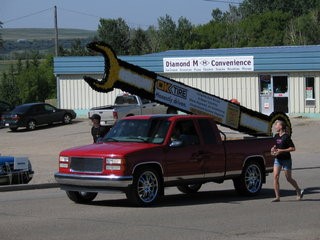
More than 50 businesses call Linden ‘home’ providing goods and services to the consumers of the community. Linden welcomes the entrepreneurial spirit and invites you to investigate the opportunities for business expansion.




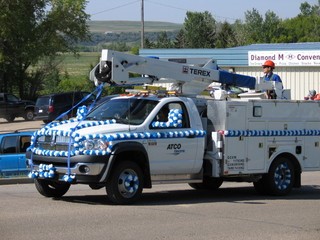
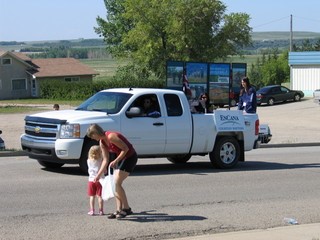
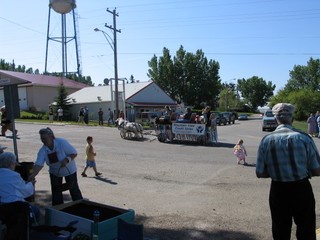
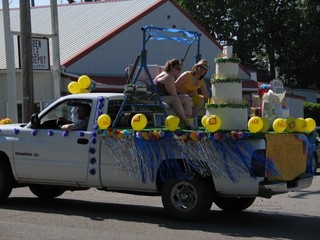
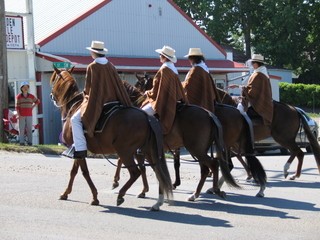
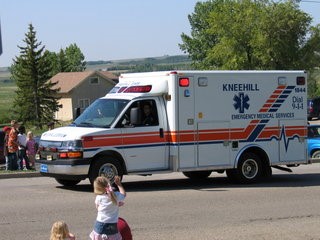
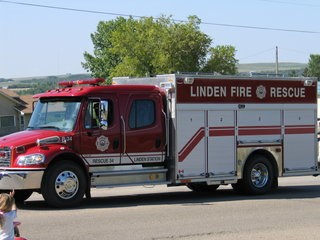

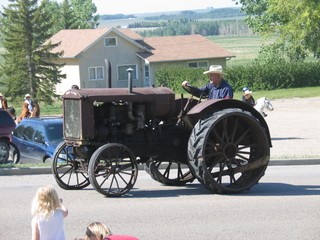
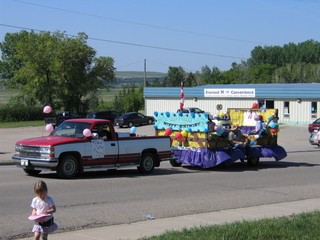
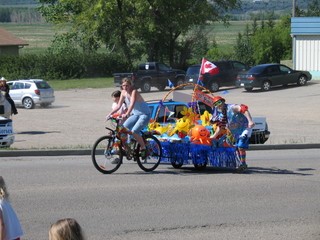

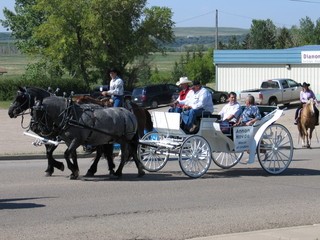
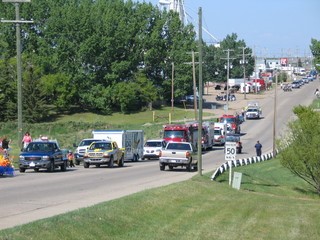
Fitting in Other Plans
The Village of Linden has been actively working towards future planning for this community. A summary of existing tools, infrastructure and resources is compiled below, as well as acknowledgement of the challenges that Linden is currently facing.
Current Plans and Developments:
Municipal Development Plan
Community Services:
Linden& District Heritage Society
Linden Municipal Library located at Dr. Elliott Community School, public computer access/wireless internet access
Linden & District Agricultural Society
– hosting Sports Day Celebrations
– hosting “Linden Fall Fair”
Linden Fire & Rescue
Ladies Ministries (Linden Alliance Church and Linden MB Church)
Mothers & Toddlers Play Group
Linden Art Society
Linden Care & Share Society
Linden Cultural Centre can be used for almost any occasion and is a joint use facility between the school and the Village
Linden Wellness Centre
Community Futures Wild Rose
Golden Prairie Parent Link Centre
Kneehill Adult Learning
Kneehill Community Resource Program
Kneehill Read Projects
Kneehill Regional Family & Community Support Services
Rural Animal Rescue Society
Seniors Outreach Program in Three Hills
Senior Men’s Slow-Pitch
Soccer
Several Youth and Young Adult Groups run through the various churches
Grants Received / Applied for:
RinC – recreation infrastructure grant – upgrade or build new recreation facilities for the Village – declined
STEP – Summer Temporary Employment Program – supplement wages paid to 1 or 2 seasonal workers during the summer months
Kneehill County Community Grant – received funding towards the adult fitness park
Encana Corporation – received funding to purchase a fountain for Coulee Dam
Kneehill County Recycling Grant – to fund collection and disposal of cardboard
Public Works
1st Street Slope Stability and Roadwork project
Sidewalk Replacement & Upgrades
Ashphalt Repair and Replacement on selected streets – funded by AMIP, SIP, MSI and NDCC
6th Street Subdivision – serviced 10 lots funded by MSI, AMIP and bank loan
New Mower
Gathering Community Input
The MSP committee referenced back to several meetings that were offered to residents.
June 17, 2009: – Initial CAG Orientation meeting and Sustainability Principles –information taken from the AUMA MSP Guidebook.
Community Vision Survey distributed in each community to develop useful information to be used at the regional visioning session July 22-23, 2009. Methods of distribution varied between communities including website, newsletters, utility bill mail outs, separate mail outs.
Media releases to promote the MSP process throughout the region.
Regional Citizens Advisory Group Visioning Session held on July 22-23, 2009 with expert facilitator Gordon McIntosh to develop community visions for all the communities. All CAG’s were invited to participate in a two day intense session to develop the community vision for each community.
The 2 day session was very informative and produced some great results. The attendance was great and the individual community CAG’s had a great opportunity to network together and learn from other community experiences and knowledge.
November 18, 2009 – All the information from the regional visioning workshop was presented to the CAG group.
December 3, 2009 – CAG meeting to follow up with actions and strategies.
January 14, 2010 – CAG meeting to follow up with actions and strategies.
January 18, 2010 – CAG meeting to follow up with actions and strategies.
March 29, 2010 – Meeting with Village of Linden council to present MSP and pass a motion to present the Draft MSP to the public.
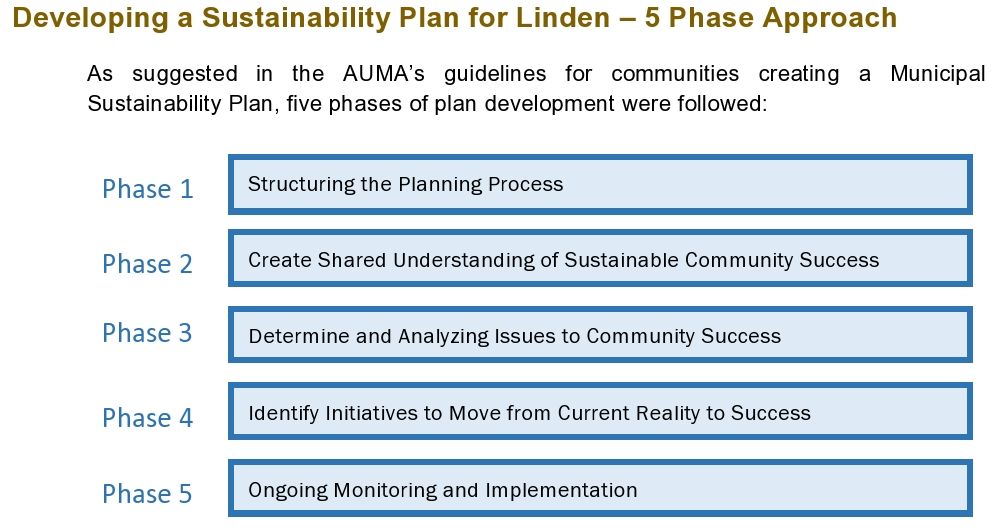

Imagine the Future – Phase 1
Established through Council, Staff and Consultant planning sessions, the community has been working on a variety of things that revolve around Vision Statements.
Values: communication, affordability, safe, attractive, culture & heritage (diverse), sustained environmental area, welcoming and caring.
The Vision Statement looks into the long term future, in order to guide the Village over the short term and provide some more detail. At recent CAG meeting / Open Houses, residents had the opportunity to propose Vision Statements:
Proposed Vision Statement: “We are more than just a pretty face. We have depth, character. We are safe. Participatory. We have layers. We’re moving and changing.
As part of the Village’s strategic planning, an Official Vision Statement was confirmed for the Village and will be used as the guiding vision which sets the stage for development over the next 30 years.
Official Vision Statement: “We are a community with depth and character – a place rich in diversity of culture and heritage. We pride ourselves on the safety of our streets, welcoming nature of our people and the shared desire to promote strong family values and preserve our rural Alberta environment.”
Visioning characteristics
– Communication involvemen
– Light environmental footprint
– Strong family values
– Community unity
– Value the individual everyone is unique
– Natural beauty
Define Success – Phase 2 (attached as Appendix A)
For the purposes of this report, success was defined by major theme area for each dimension based in part on the comments received from the community workshops as well as the strategic plans and documents that Council(s) have adopted.
This information is summarized in Appendix A, Backcasting Analysis, together with the Current Reality and proposed Actions for each dimension.

Current Reality – Phase 3 (attached as Appendix A)
The point of working on these two descriptions is to develop creative tension, in other words to identify the gap that exists between current reality and future success. For example, some communities may identify “Water” as a key strategy area for their community. In this case, Council and citizens describe the characteristics of their community’s water system if they achieved their sustainability vision, and then describe the current reality of “Water” in their community. This creative tension will aid in generating new ideas for initiatives and investments to “bridge the gap”, which is the focus of the next phase.
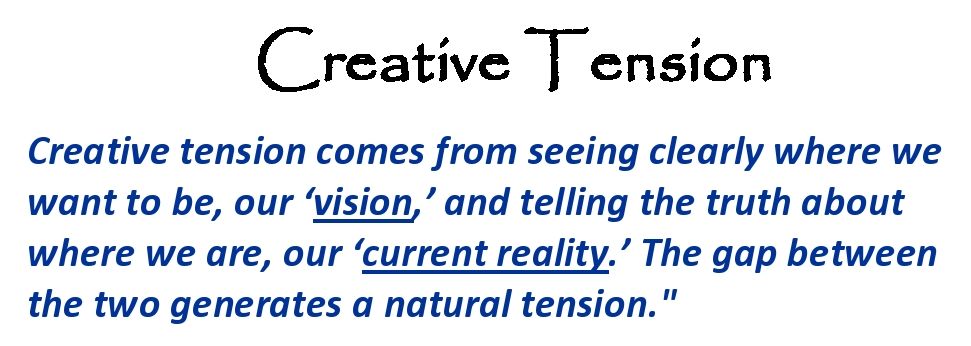

Action Plan – Phase 4
Action Plan Charts (attached as Appendix B)
The descriptions of success proposed for each dimension must be attainable through action and use of available resources. Prioritization based on the community’s needs while providing for future investment is a matter of balance. The challenge is to efficiently apply the proper resources to undertake those initiatives that provide desirable returns over the long term.
Four questions can be applied to each of these actions to assess their value. They are:
1. Will this action move us toward Linden’s definition of success?
2. Will this action move us toward the Sustainability Principles?
3. Will this action provide flexibility for future community leaders to take action?
4. Will this action generate sufficient economic and political return to seed future investments?
Implementation & Monitoring – Phase 5
Within the Action Plan, responsibilities, timelines and resources have been suggested to guide each strategy’s implementation. Much of the work ahead will depend on the commitment of the community’s leaders and its citizens, working together to achieve their common vision of success as adopted by this Plan. The Action Plan cannot be static; it requires the input and participation of its stakeholders over time to ensure that the desired results are being achieved. And if not, what modifications are necessary to lead the way to achievement?
Council can and will be leaders in sustainable practices and decision making. The principles of sustainability must be enveloped within the community’s statutory documents, bylaws, policies and other municipal programs and services, to further support the ongoing success of this Plan. Reviews of these documents will be mandatory to ensure their alignment with this plan as it too changes over time.
Community involvement is a must for the successful progression and implementation of this plan. A community planning session is being organized by the MSP committee for early 2009, where a qualified facilitator can educate and lead participants through the process of sustainability planning. This plan can serve as a starting point from which to systematically build and improve.
Future planning sessions for Council leaders and staff members will continue to precede the onset of annual budgeting deliberations, like in the first quarter of each year. Improvements to the Budgeting Process are continually being made with the support of council in adding and modifying practices for fiscal efficiencies and sound decision making. The MSP document will be reviewed and updated during this process, prior to adoption of the long range capital plan.
Figure 3 – Implementation of Municipal Plans
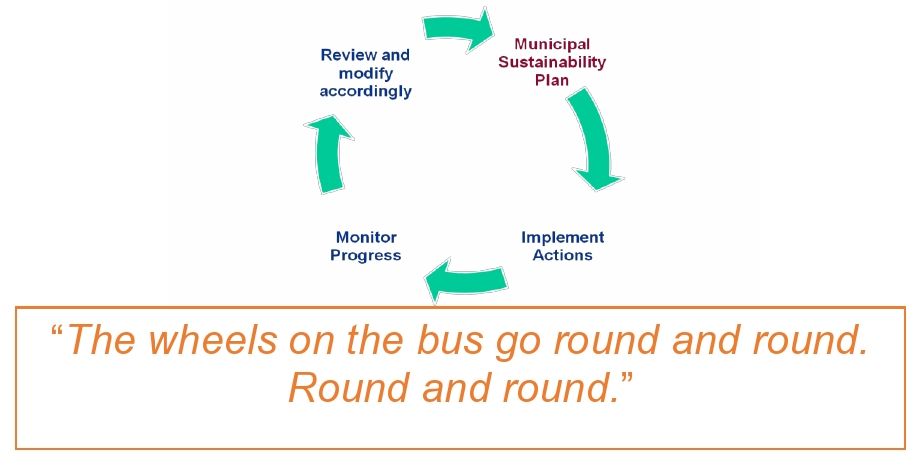
Linden’s Sustainable Future – Conclusion
This document comprises Linden’s Municipal Sustainability Plan. It follows the Alberta Urban Municipal Association (AUMA) Sustainability Planning Guide which was referenced throughout the creation of this document.
Through the Plan implementation, overall community support will be tied to strategic planning, grant funding opportunities and identification of benefits realized. Village of Linden will assist the community in remaining focused on the exciting vision they have for the future and will provide the foundation and direction to make that vision a reality.
The success of any plan depends on the efforts that are directed towards great decision‐making. This MSP provides the direction for Council, Village Administration and Village residents to evaluate development proposals, in the context of a long‐term plan for Linden. Several measures beyond those specified in this document may also be used by Council to implement this Plan. In addition to specific bylaws, Council may adopt administrative procedures that will improve the efficiency of implementing policies in this Plan. Moreover, implementation of this Plan will require the input, support and cooperation of residents and stakeholders from the private and public sectors.
The Village of Linden was selected as one of six pilot communities to develop municipal based initiatives for achieving sustainability through the development and implementation of a Municipal Sustainability Plan. The experience and understanding that the Village of Linden has gained for its own community will help establish a standard of directional excellence for other communities to follow as they begin their journey to sustainability
Valuable and pertinent information received from community members has been instrumental in guiding the Municipal Sustainability Plan to become a document that defines not only the Village of Linden, but the commitment and vision of a sustainable future for all residents. The successful community engagement process has been highlighted by well publicized Open Houses, workshops, press releases, questionnaire distribution and mail outs. Linden residents care deeply about their community and look forward to a prosperous and sustainable future.
Engaging in the five “Dimensions of Sustainability”; Governance; Economic; Environmental; Cultural; and Social, has assisted in providing connectivity and balance of foundational elements that residents’ value, which in turn has led to establishing prioritized goals.
A realization that this plan, its actions towards achieving our goal and even the goals themselves, are not set in stone, is key in the overall development of the plan. Continued public engagement and fine tuning will necessitate the evolution of this Municipal Sustainability Plan as Linden advances into the future.
By planning for Municipal Sustainability, Linden will endeavour to preserve its sense of community, build a strong economic atmosphere, introduce diverse recreational and cultural opportunities and encourage environmental conservation for its residents.
The next step in the Sustainability Plan process is moving from planning to implementation. For this Plan to be successful it must advance beyond the planning to become a part of the official policies and practices of the community. This document provides the Village of Linden with the strategies, goals, initiatives and action opportunities to create a sustainable community.
